Garlic is actively used by housewives, so how to properly preserve it remains a very pressing issue. The experience of real gardeners makes it possible to become familiar with many ways to preserve crops for a long time without losing taste and beneficial properties.
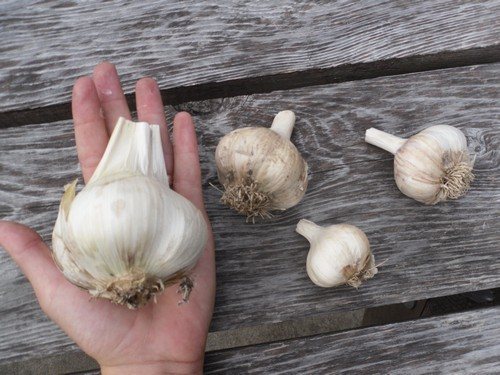
- Which one is better to store?
- Spring
- Winter
- How to prepare for storage
- Timely and proper cleaning
- Drying
- Trimming
- Preservation of scales
- Sorting
- The necessary conditions
- Light
- Humidity
- Temperature
- Ventilation
- Separate storage of different varieties
- How to store
- In a braided braid
- In conjunction
- In paraffin
- In boxes and crates
- In the basket
- In grids
- In fabric bags
- In pantyhose and stockings
- In the sawdust
- In cling film
- In onion skins
- In flour
- In salt
- In the ash
- In the bank
- In oil
- Purified
- Dried
- Ground
- Where to store
- In the apartment
- On the loggia and balcony
- In a refrigerator
- In the freezer
- Other places
- In the cellar and basement
- Shelf life
- Spring storage
- Garlic for planting
- Storage problems
- Garlic dries
- Fungus and mold damage
- Germination
- Rot
- Best varieties for storage
Which one is better to store?
Different types require different approaches to organizing storage. It is important to collect young garlic on time and dry it well; the duration of storage largely depends on this. You can’t tell the difference between spring and winter varieties by taste, but the planting time and harvest time are different.
Spring
The mature head is flattened and contains up to 50 small teeth. It is covered with hard leathery scales. The leaves are narrow and long. Housewives choose spring garlic for long-term storage, but it is inferior in head size and yield. It is planted in early spring after the snow melts, when the ground warms up to 5°-7°C.
Harvesting occurs in the last weeks of August, when most of the leaf blades have already turned yellow and bent towards the ground. Half a month before harvesting, stop watering summer garlic.

Winter
The heads of winter garlic are large, up to 9 cloves, and they are located around the petiole. The leaves are wide, each of them feeds one clove. The duration of storage depends on the variety.
The winter type is planted in September, in good weather. The first shoots appear immediately after the snow melts. Winter garlic shoots out arrows in which bulbil teeth grow. They take most of the nutrients, so the bulbs become small. To avoid this, experienced housewives remove the arrows.
Harvesting occurs when the leaves turn yellow and the stems fall, this indicates the maturity of the vegetables.
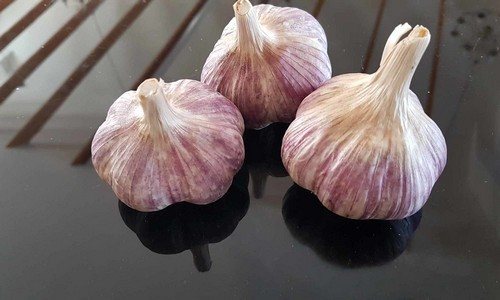
How to prepare for storage
You need to carefully prepare garlic for winter storage, taking into account many factors. There are nuances that should not be ignored.
Timely and proper cleaning
You cannot delay cleaning, otherwise the heads will fall apart. Each type of garlic has its own harvest time, this is taken into account when planting. Spring crops are harvested in the second half of August. The approximate time for harvesting winter crops is the end of July, but you need to focus on ripening, which is evidenced by the cracked skin of the inflorescences or by the thinning of the covering scales of the heads.
You need to dig in dry weather and very carefully so as not to damage the heads.More often, a pitchfork is used for this rather than a shovel. If the harvest is harvested on time, it will be stored for a long time.
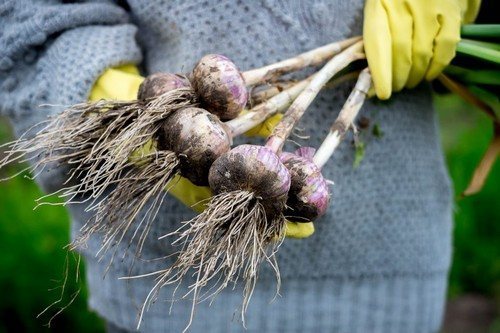
Drying
After harvesting, the garlic is cleared from the soil by hand. Washing is strictly not recommended to avoid rotting. The harvest is laid out on newspapers or hung in bunches by leaves. There are two ways to dry:
- Outdoors, for 3-5 days in good weather and during daytime, but not in direct sunlight. This method is the most popular, as it does not require any special conditions and increases the crop’s resistance to diseases.
- Indoors, if it is well ventilated and the humidity level is not too high. An attic, loggia or balcony is perfect for this.
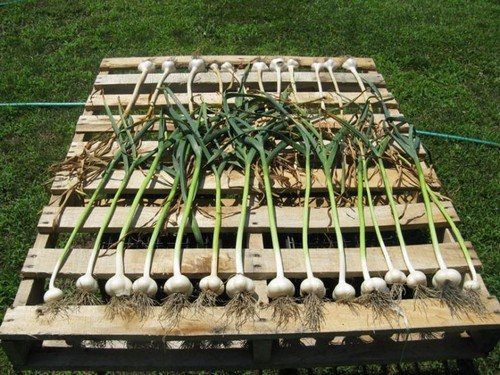
Trimming
After harvesting, the roots are removed before drying, and the foliage is left to protect the garlic from drying out and preserve beneficial substances. When the garlic is completely dried, cut off the leaves with scissors, leaving the desired length, which depends on the chosen storage method. For braids, a length of 40cm will be enough, for buns – 20cm, and for the rest, 2cm will be enough.
Prudent housewives burn the bottom of the garlic heads with a candle to prevent germination. This is often done for spring varieties stored warmly.

Preservation of scales
Whether to leave or remove the scales depends on the chosen storage method. If you store whole heads, then the scales are left, protecting the vegetable from drying out. When storing peeled cloves, the head is disassembled, therefore, the scales are also removed.
Sorting
Only high-quality heads of garlic will be preserved for a long time, so selection must be carried out carefully. Should be deleted:
- fruits that are damaged or have peeled off the skin;
- empty heads;
- garlic affected by rot or disease.
The duration of storage of the crop directly depends on the preparation process, so housewives pay the greatest attention to this stage. Each head undergoes careful selection.
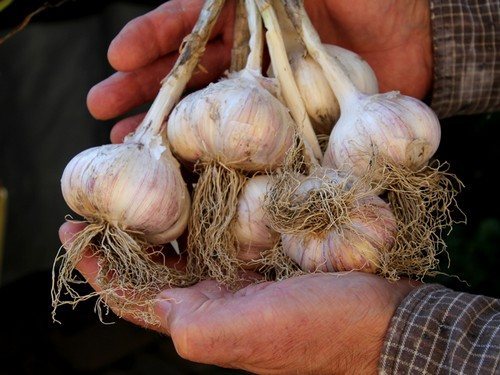
The necessary conditions
The shelf life of the crop also largely depends on the conditions created. Compliance with them will allow you to have access to a juicy vegetable with excellent taste all winter.
Light
Any place where there is no direct sunlight is suitable for storing garlic. This will help preserve the beneficial properties of the harvested crop, and also keep the amount of vitamins and minerals at the same level.
Humidity
Maintaining humidity at 50-80% will be comfortable for storing crops. Such conditions will not allow the garlic to dry out or become moldy.

Temperature
The temperature depends on the type of garlic. Warm storage at air temperatures from +16° to +20°C is typical for spring. For winter crops, the optimal temperature is around +2°- +4°C. Maintaining the temperature regime will maintain the safety of the heads and protect against many diseases.
Ventilation
This condition is mandatory when storing garlic openly, without additional devices and substances, for example, for storage in braids, baskets, bundles, nets, etc.
Separate storage of different varieties
There are more than 70 types of garlic, each of which has its own characteristics not only in care, but also in storage. Experienced gardeners know about them, but if you are an amateur, you should rely on the general requirements for good preservation of the crop.
Garlic is not only stored separately from other vegetables, but also different varieties are kept separately in winter.This is done in order to avoid spoilage of crops that have a longer shelf life compared to crops that have a shorter shelf life. When choosing a particular variety for planting, this should be taken into account.
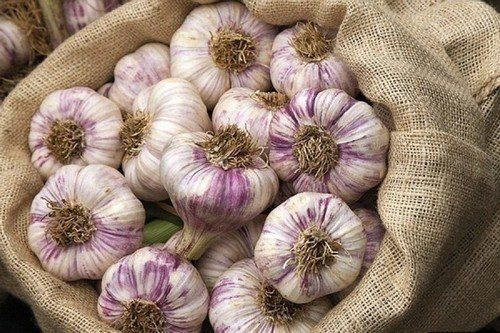
How to store
Housewives go to all kinds of tricks to preserve their harvest, grown with great difficulty. Each invents something of its own, based on its own experience, as evidenced by the wide list of ways to store garlic.
In a braided braid
This method can be called grandma's, time-tested and most common. The braid is woven from heads, of which there can be up to 15 pieces. False stems no longer than 40 cm are woven, and then excess foliage is removed.
For strength, twine is sometimes woven in. Select the largest head, tie it with twine, you get two ends of the rope and a stem in the middle. They take the head, apply it to one end and begin weaving, then apply the third head to the second end, weave it in, and so on in turn. It turns out to be a braid, at the end of which a loop is made of twine. Using it, the braid is hung in a dark, cool place with optimal humidity.
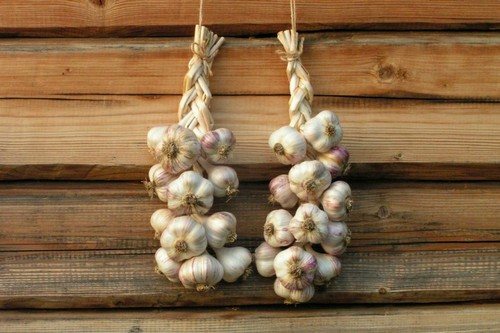
In conjunction
The simplicity of the method lies in the absence of weaving. Take an armful of garlic with stems no more than 20-30 cm long and tie it around the heads with twine or rope. In this form, the bundle is also hung in a room with suitable storage conditions, for example, in a barn or attic.
In paraffin
The point of this method is to prevent moisture evaporation and protect garlic from diseases by forming a protective film of paraffin. It is prepared from candles that are melted in a water bath at a temperature of 60°-70°C.The heads are dipped in there for 2-3 seconds, then removed and the excess paraffin is allowed to drain off.
This storage method does not require the organization of a special microclimate, so the harvest after waxing can be kept in a cardboard box in the pantry or in the bottom drawers of cabinets in the kitchen. The crop is folded by hand so that the stems do not damage the heads.
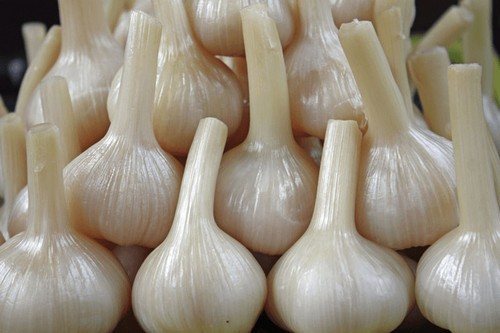
In boxes and crates
Storage occurs with whole heads that are not cleaned. Plywood boxes, which must have holes for air circulation, or shallow cardboard boxes are suitable.
The garlic is placed in a box or box, alternating layers with sawdust or salt, for example. The top layer must be of a loose composition to form a protective cover. During the winter, it is recommended to inspect the crop a couple of times for spoiled heads, and then add layers again.
In the cellar, boxes are placed away from cabbage, potatoes, carrots and other vegetables, because they spoil faster and can contaminate the garlic.
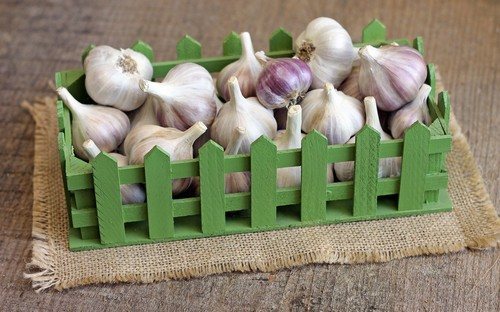
In the basket
An ancient method of storage. The design of the basket allows air to circulate freely through the walls, so the garlic in the basket will never become moldy and the chances of it getting sick are minimal. But you should still sort through the crop at least 2 times during the winter. Baskets are placed separately from containers with other vegetables.
In grids
In terms of space saving, grid storage is very popular. They hang higher and don't get in the way. The garlic is placed in nets carefully so that the left tails do not damage the bulbs.
Constant access to air prevents the crop from becoming infected with mold, but does not provide much protection from overdrying or germination, so it is necessary to periodically inspect the garlic and remove spoiled heads.
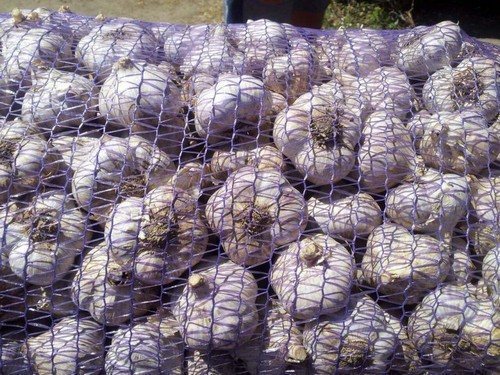
In fabric bags
A fabric bag provides a good shelf life. But it must be made of natural material. The bag is specially prepared for use by soaking for a minute in a concentrated salt solution and then drying well. This is done to reduce the risk of disease or mold. Garlic is stored in untied bags.
In pantyhose and stockings
Quite an old and simple method, still relevant today. The heads of garlic are placed in tights or stockings and hung on the wall, higher, so as not to interfere. The density of nylon does not restrict air flow, which protects against mold and rot. At the same time, it is very fragile, so you should fill the stockings carefully so that leaving dry legs does not damage it.

In the sawdust
Garlic heads are placed in a plywood or cardboard box, sprinkling layers of vegetables with sawdust, alternating. The last layer of sawdust should completely cover the garlic. A greater effect is achieved when using sawdust from coniferous trees.
The box is placed in a dark, cool place separately from other vegetables and periodically checked for spoiled onions, and then refilled.
In cling film
Each garlic head is wrapped in cling film. The tighter you make it, the better. This method will perfectly protect the vegetable from drying out. It will only be effective if the garlic is well dried beforehand, otherwise it will deteriorate under the film.
Wrapped bulbs can be stored in boxes, baskets or drawers in cool, dark rooms.

In onion skins
The garlic is placed in a box, drawer, basket or bag.Onion peels are poured in there so that each head is covered with them. It is best to alternate layers with peels. They completely cover the heads, forming a protective final layer. Then the container is placed in a dark place away from other vegetables. During the winter, the harvest must be sorted, removing spoiled onions, and poured again.
In flour
This method is popular. Flour removes excess moisture, but does not allow it to dry out. You can store it in any container, both in a saucepan and in a jar, the garlic is laid out in layers and sprinkled with flour. The last layer covers the heads completely. Jars are closed with polyethylene lids and placed in cabinets in the kitchen or on shelves in the pantry. In winter, check and remove spoiled garlic cloves so as not to infect others.
In salt
Any container from a box to a jar can also be used for storage. The most important thing is that there should be a thick layer of salt both on top and bottom, 2-3 cm will be quite enough, and between the layers of garlic, of course, but not so much. Salt absorbs excess moisture and disinfects. The container with garlic sprinkled with salt is placed in a dark place with the required level of humidity. This method ensures preservation until spring.
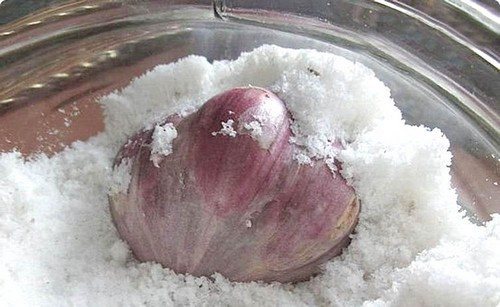
In ash
Ash has many uses in the household, storing vegetables is no exception. Garlic heads are placed in a box or crate on a pillow of ash. Then, carefully sprinkling ash in layers, the entire crop is laid out. As a result, it should completely cover the garlic heads, protecting them from excess moisture. The box can be left right in the kitchen, placed on the mezzanine.
In a jar
A jar is often used to store garlic as a container where it is placed and sprinkled with something.But there is also an independent method, according to which the jars are sterilized and dried, and then garlic heads are placed in neat rows. Even without any ingredients, garlic in jars is stored for a long time, does not sprout and does not dry out.
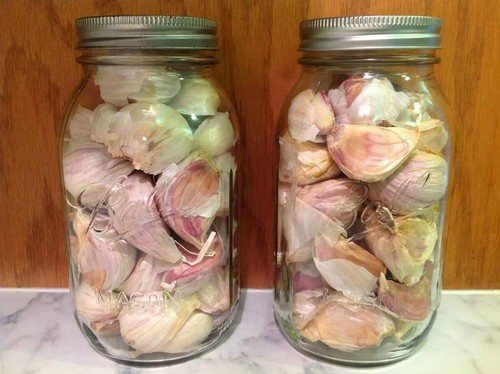
In oil
Along with bulk formulations, garlic is stored in jars with vegetable oil - sunflower or olive. Before pouring, the cloves are peeled, selecting only healthy, clean cloves. The jars are covered with nylon lids and placed in the refrigerator. The oil absorbs the garlic aroma and can later be used as a salad dressing.
Purified
Without scales, garlic cloves spoil very quickly, but housewives get out of the situation even here. Freezing is the most optimal way to store peeled cloves. You can use containers or special plastic bags for this. On the other hand, it’s convenient – you take it out and can use it right away without wasting time on cleaning. Well, storage in oil, we already know about it.
Dried
Just like herbs, garlic can be dried and stored as a seasoning. Dry it in electric dryers or ovens at +60°C, pre-cut into thin plastics. The dry mass is ground with a blender and poured into a clean, dry glass or tin jar. You can store garlic seasoning for a whole year without harming it. It should be said that due to heat treatment, a significant portion of the beneficial properties will be lost and a specific smell will appear, but this does not bother most housewives.
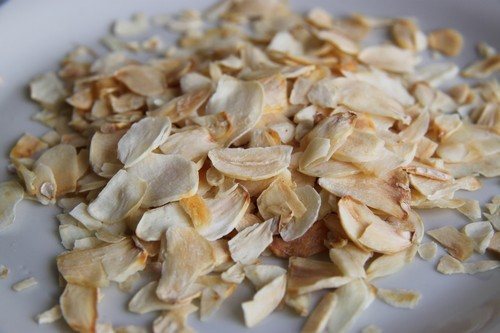
Ground
Garlic cloves are peeled and ground using a blender to obtain a paste.Then pour olive oil into it, add salt and mix, the garlic mass is ready for use. Store in jars under plastic lids or in food containers. The aromatic gruel will not lose its beneficial properties with this storage method. Ground garlic is stored for about 2 weeks.
Where to store
You can store garlic at home for a long time if all conditions are met. Each storage method requires a certain temperature regime, humidity level and degree of illumination. The choice of storage method should be based on the capabilities of the room, therefore, where it is better to place the crop should be considered individually.
In the apartment
Methods and places for placing the crop depend on the dimensions of the apartment, the presence of a pantry, balcony or loggia.
On the loggia and balcony
The balcony should be unheated, but insulated and have a corner closed from direct sunlight. In winter, the temperature on it should not drop below 0 ° C. The loggia is equipped with shelves for containers with garlic or hooks for braids, bundles or nets.
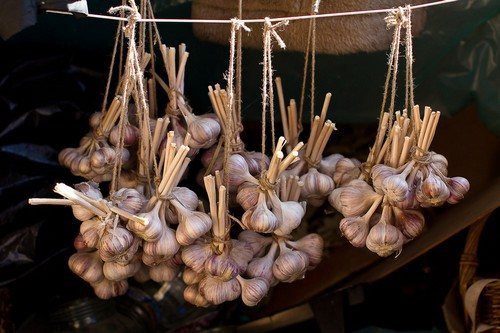
In the refrigerator
In the cold, peeled garlic should be placed in jars with oil or ground. Is it possible to say here how long garlic will be stored in one form or another, it all depends on the speed of its use.
In the freezer
Low temperatures are necessary for peeled garlic, which is frozen and stored like this for a short time. It is placed in special freezer bags or small disposable containers.
Other places
This includes pantries, utility rooms, attics, kitchen cabinets and mezzanines.
In the cellar and basement
These rooms are suitable only if the ventilation system is well-functioning and there is no high humidity, which is definitely not conducive to long-term storage of vegetables. You can place boxes, crates, baskets there, or hang bunches of garlic.
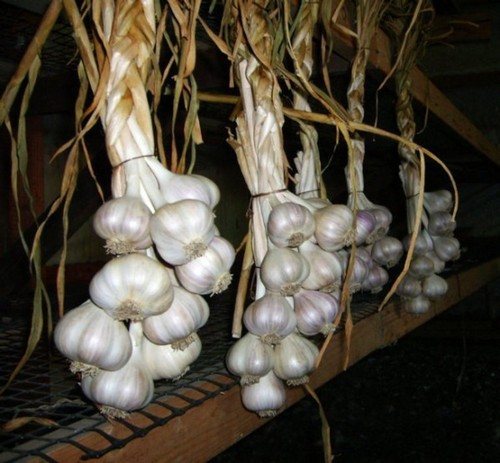
Shelf life
Optimal conditions must be created in storage areas, which determine how long the garlic will remain fresh and not susceptible to the spread of fungus.
| Storage | Term |
In a refrigerator:
|
|
| Pantry, kitchen cabinets | All winter |
| Basement, cellar | 3 - 4 months |
| Attic, balcony | 4 to 6 months |
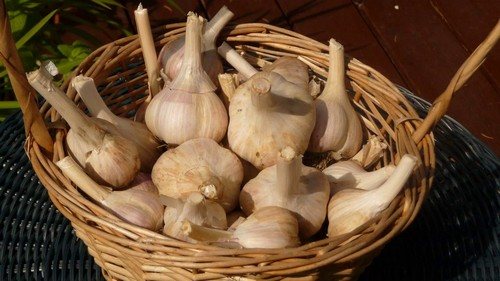
Spring storage
In the spring, winter garlic begins to sprout, and if by this time there is a harvest left from last year, then this is simply wonderful. Spring storage methods are no different from winter storage methods. If the temperature is maintained in a ventilated room, the harvest will last until summer. The most important thing is to periodically inspect the harvest and remove spoiled bulbs in a timely manner.
Garlic for planting
The gardener will receive a good harvest only if the planting material is of high quality and stored at a minimum positive temperature in a cool room. Teeth for planting are selected that are healthy and large, without damage.
Preparations for planting in open ground begin in March - April for spring garlic. To do this, the cloves are kept in the refrigerator from the beginning of spring.
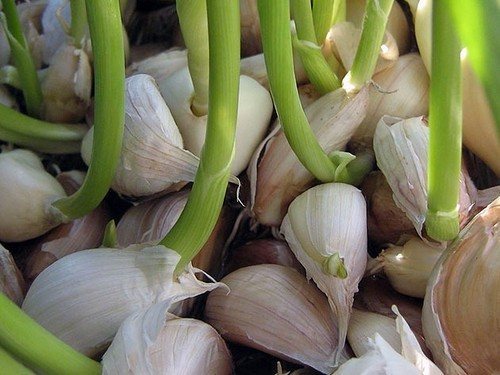
Storage problems
It is not always possible to ensure that all storage conditions are observed, and it turns out that the garlic has spoiled.
Garlic dries
Looking through the supplies, dry heads were discovered, as if all the juice had been drunk from them. This occurs as a result of moisture evaporation. To prevent the vegetable from drying out, create a protective paraffin layer or wrap the heads tightly with cling film, this preserves its juiciness.
When storing, avoid high temperatures and direct sun, keep humidity at the right level, this will help prevent the vegetable from drying out.
Fungus and mold damage
The appearance of mold on the crop is caused by poor drying before storage or inattentive sorting, when spoiled heads end up in the overall harvest. Fungus and mold spread quickly. Careful harvest preparation is important here. Thorough drying after harvesting will help to avoid such a disaster. It will make conditions unfavorable for the growth of fungi and bacteria.
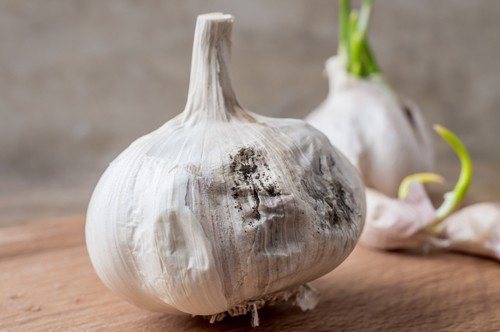
Germination
A sign of germination is the sprouting of roots by garlic. To prevent this, housewives set the bottom on fire. Such manipulations will extend the shelf life and prevent further germination. The sprouted heads are eaten first or cleaned for storage in vegetable oil.
Rot
Garlic rots in a poorly ventilated area with excess moisture or when placed next to damaged heads. It must be removed from the common container so as not to contaminate other vegetables. For prevention, supplies are periodically sorted and inspected. Thorough drying before storage, as well as separate storage from other vegetables, will help prevent rotting.
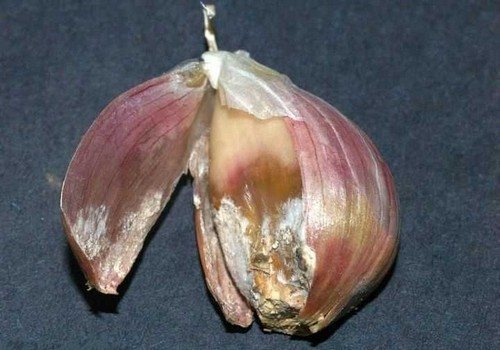
Best varieties for storage
The most shelf-stable varieties among spring crops are considered to be Elenovsky, Gulliver and Sochinsky 56. Their shelf life is 1 - 2 years. Spas, Sofievsky, Alkor - long-term storage winter varieties. Remember that varieties with different storage durations are kept separately from each other. So that a shorter-lived harvest does not spoil longer-stored garlic.
The widespread use of garlic in various fields requires the availability of fresh and healthy fruits all year round. To achieve this, you should not only create optimal conditions and carefully prepare the fruits for storage, but also carefully monitor the condition of the crop during the winter.


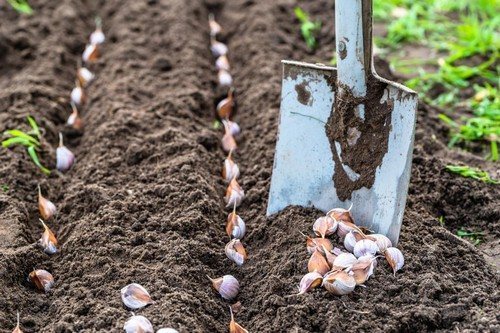


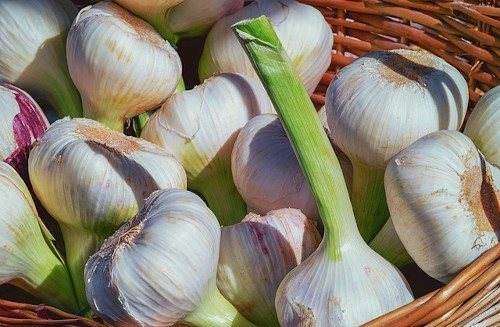
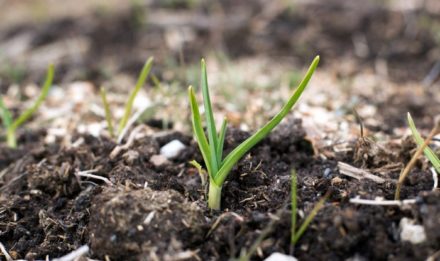
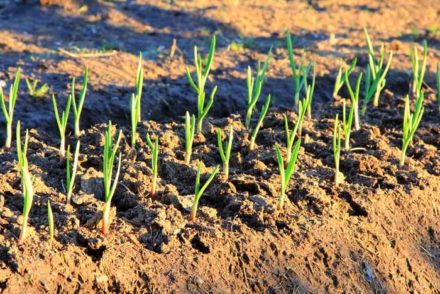
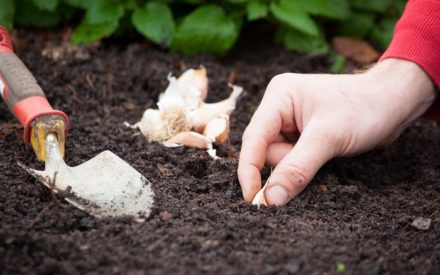
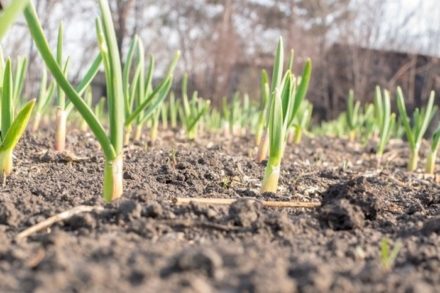


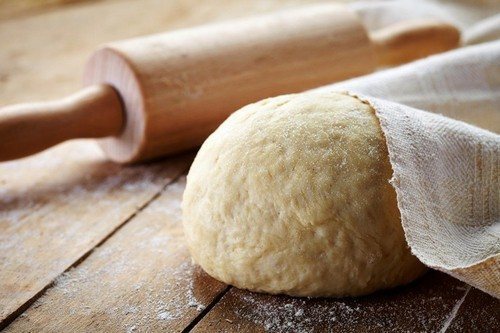
I really like the comment. Thanks a lot